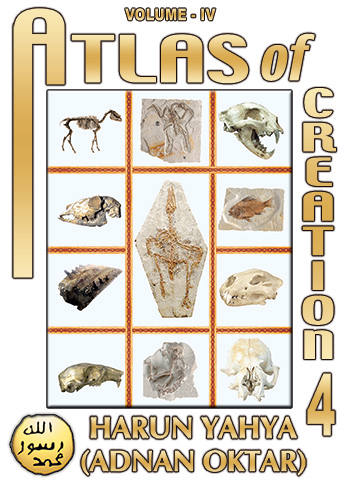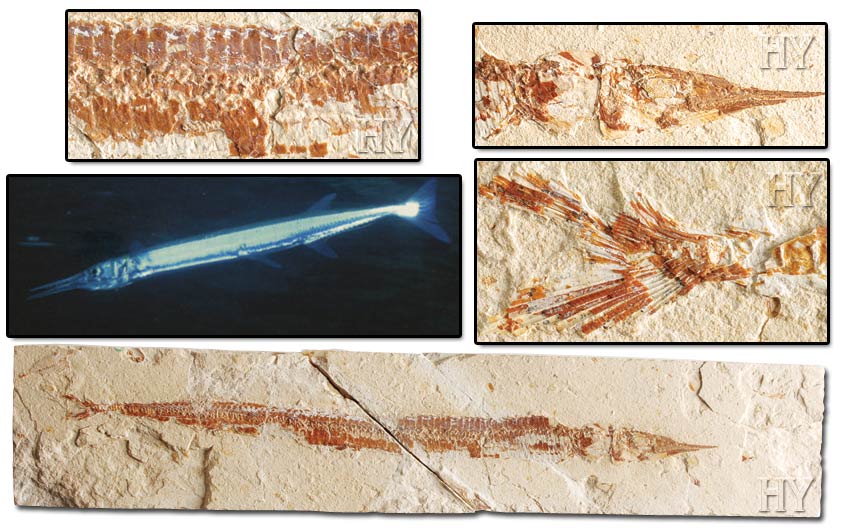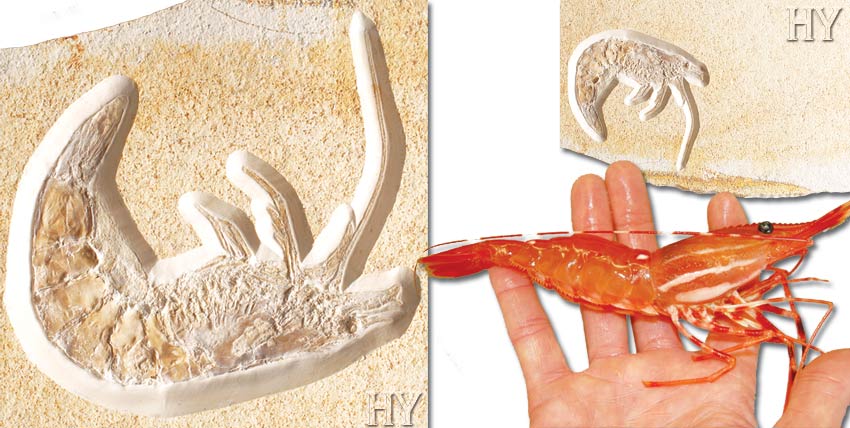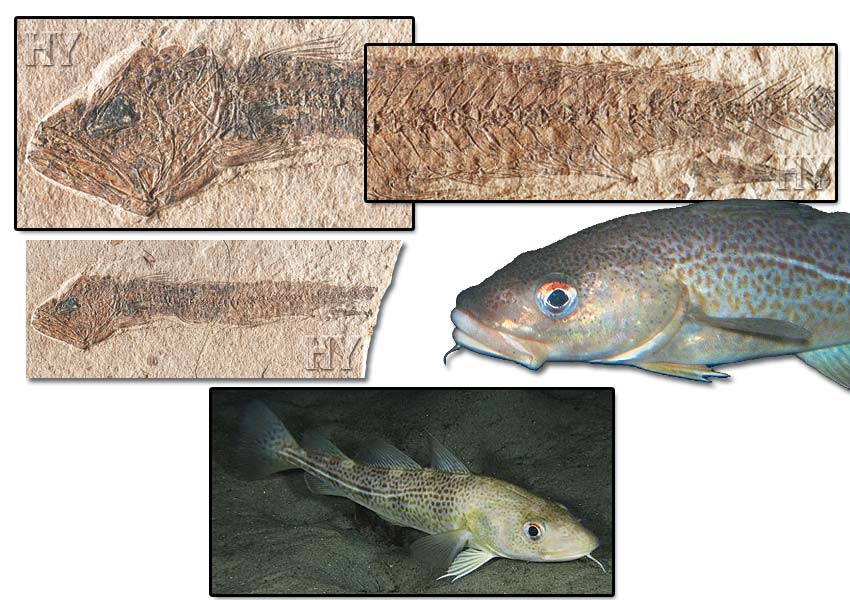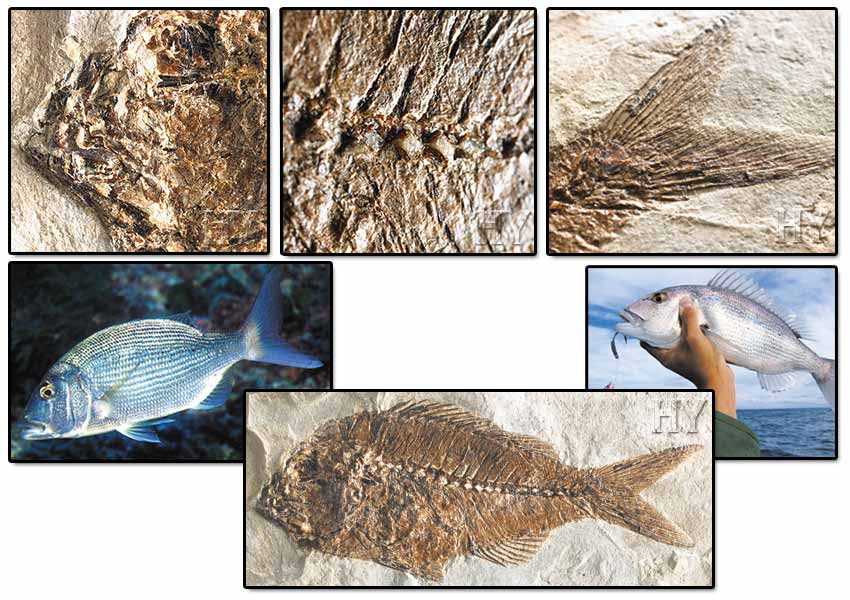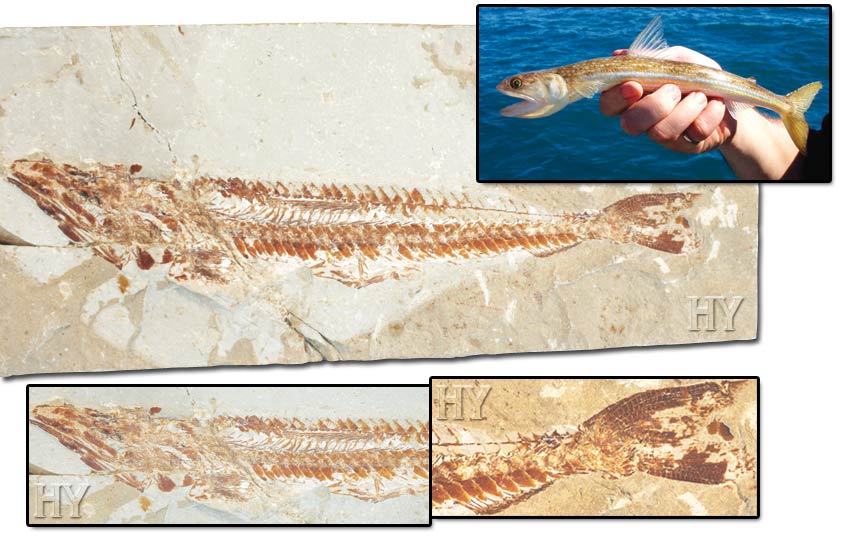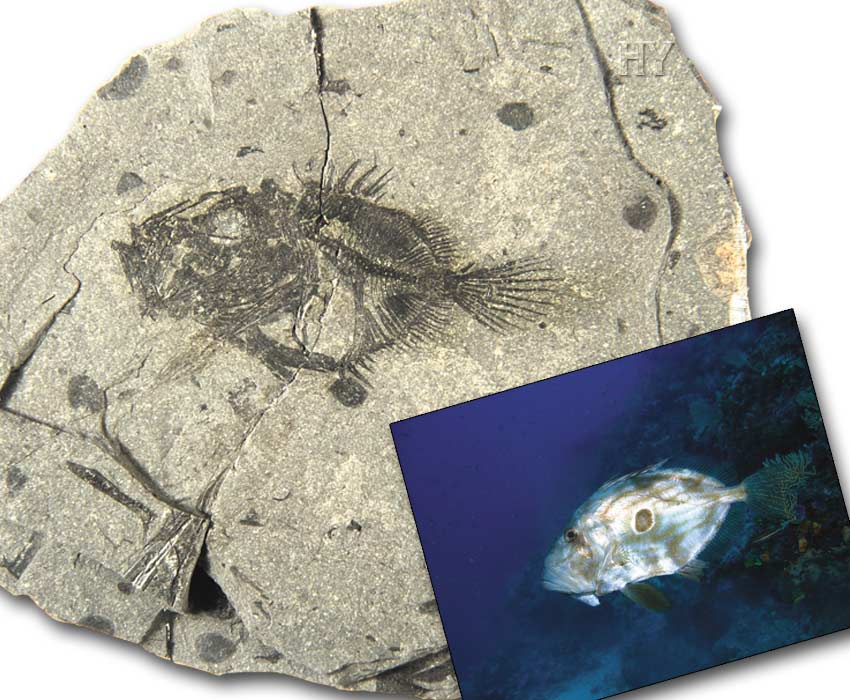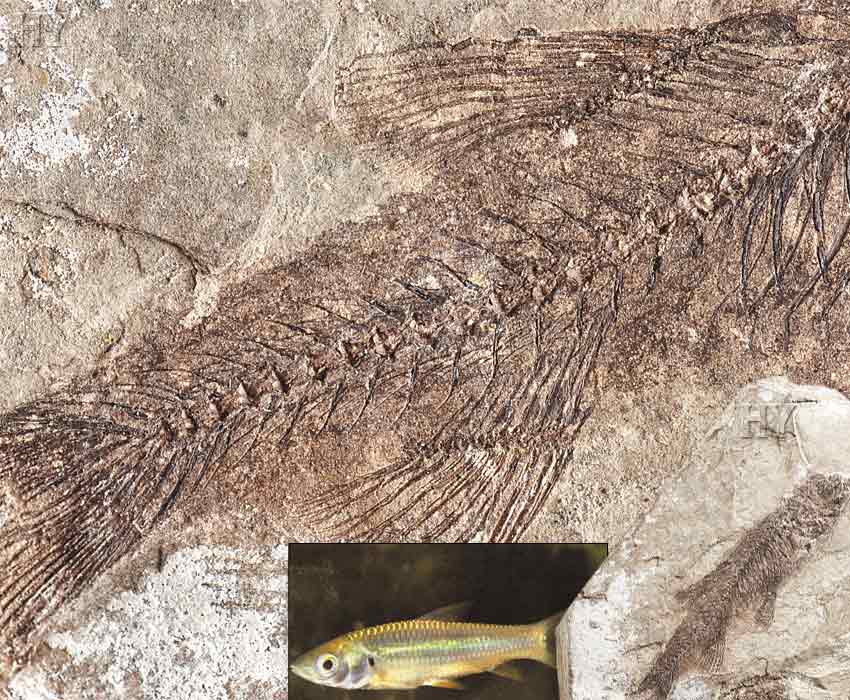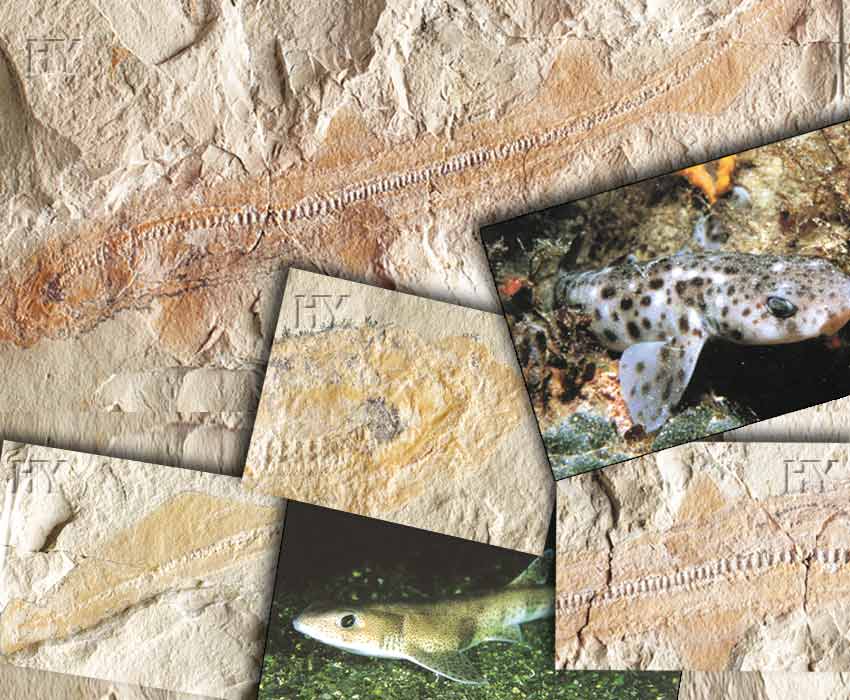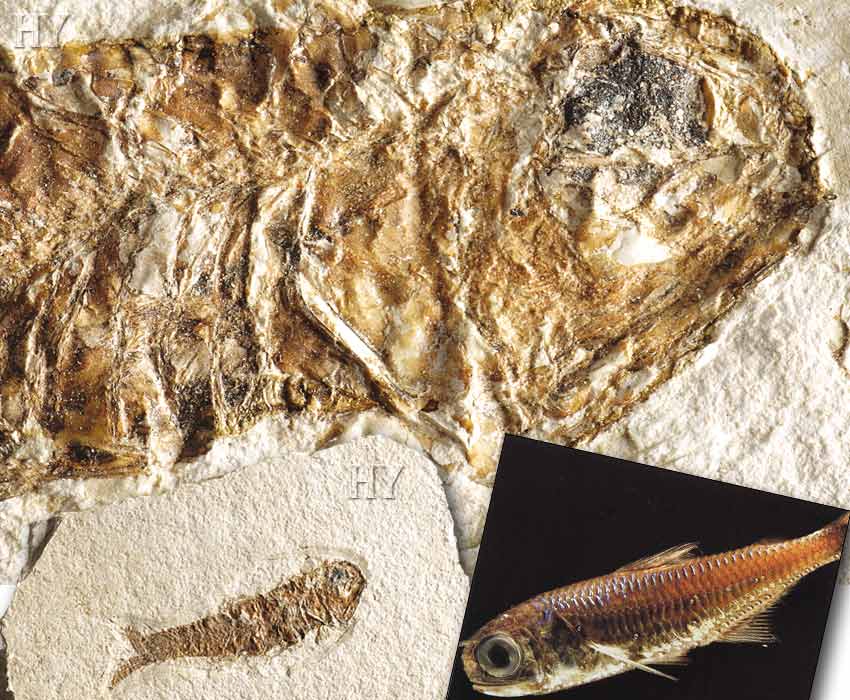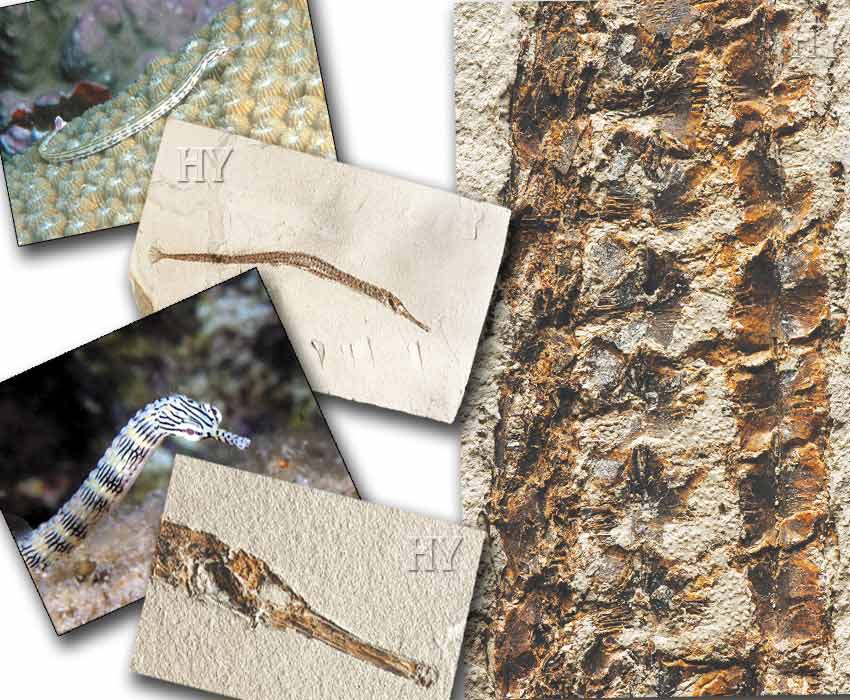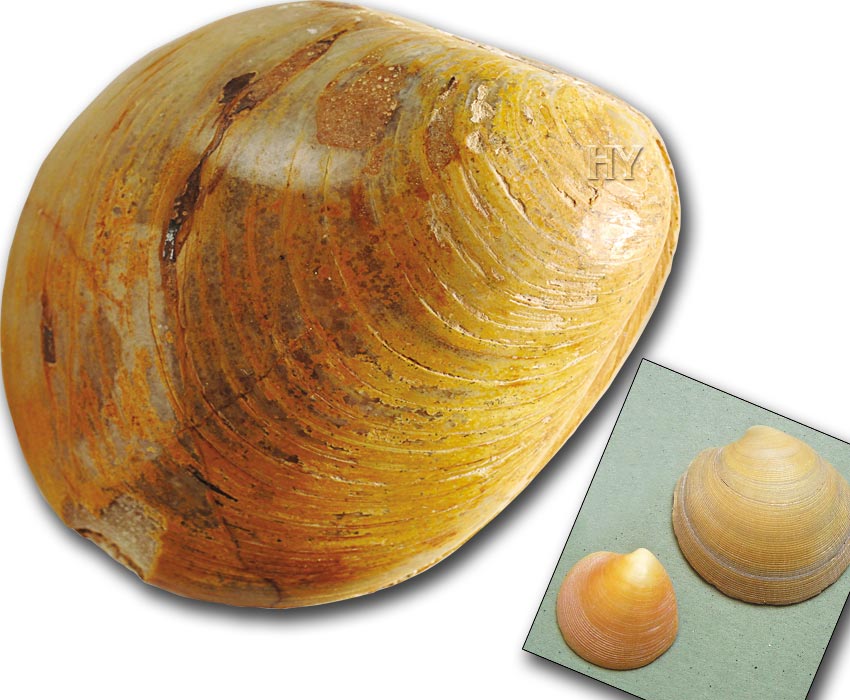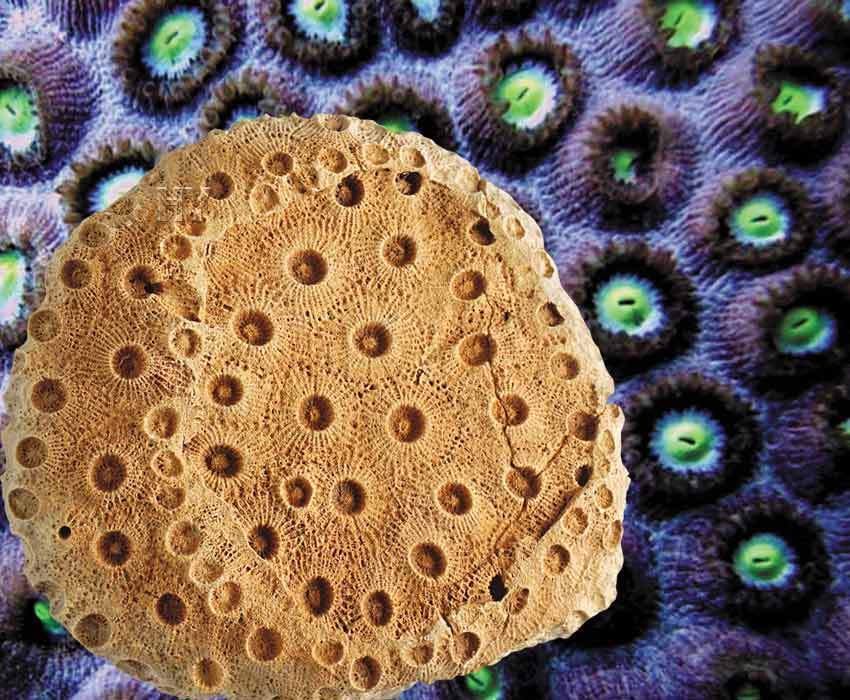LIVING FOSSILS
Marine Fossil Specimens -2
Tarpon
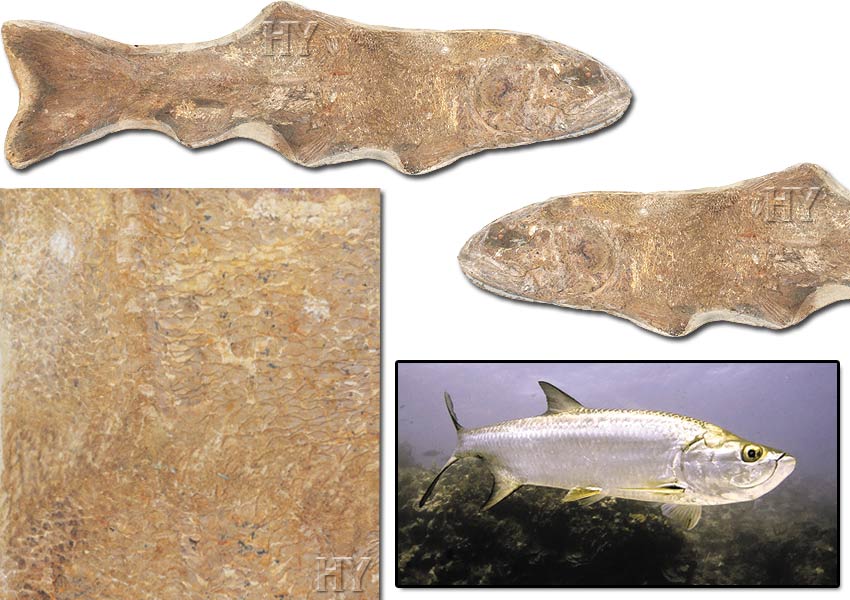
The fact revealed by fossil findings is that life forms
appear suddenly in the fossil record together with all their features, and that they never change so long as that particular species survives. All living things are created by Allah telling them to “Be!”
Period: Cretaceous
Age: 110 million years
Region: Santana Formation, Brazil
Tarpons are large fish covered in thick, silvery scales that can grow to five to eight feet long. Their upward curving lower jaw makes it easy to distinguish them. They swim very well, by means of their shuttle-shaped body and powerful tail. The tarpon is most commonly found in the warm waters of the American Atlantic coast. It sometimes comes to the western shores of West Africa. The Atlantic tarpon (Tarpon atlanticus) can reach 2.5 meters (eight feet) in length and a weight of 130 kg (287 pounds).
The tarpon reproduces in open waters and can lay up to 12 million eggs, but the young migrate to the shore and live in muddy shallows and river mouths. Adults may also approach shallow shores to hunt small fish and even enter rivers. Tarpons are popular with amateur fishermen because they are very strong, put up a fierce resistance after being hooked and can jump several meters into the air. Just as with other species, this fossil tarpon proves that these living things have never changed and never underwent evolution.
Needlefish (Belone belone)
Period: Cretaceous
Age: 95 million years
Region: Lebanon
The fossil record refutes the theory of evolution in all aspects. A 95-million-old Mesozoic era fossil needlefish is one of those that deal a severe blow to the theory of evolution. Despite the passage of 95 million years, this life form has never changed, and it has preserved its long mouth and thin body since the day it was first created. The needle fish, a member of the Belonidae family with a long and thin body, can attain lengths of up to one meter (3.2 feet) and lives for 18 years on average. The needle fish feeds on small fish such as sprats, whitebait and sardines. A comparison of a living needle fish specimen with a 95-million-year-old fossil clearly shows that these living things never evolved and that Almighty and Omniscient Allah creates all life forms.
Ranila Crab
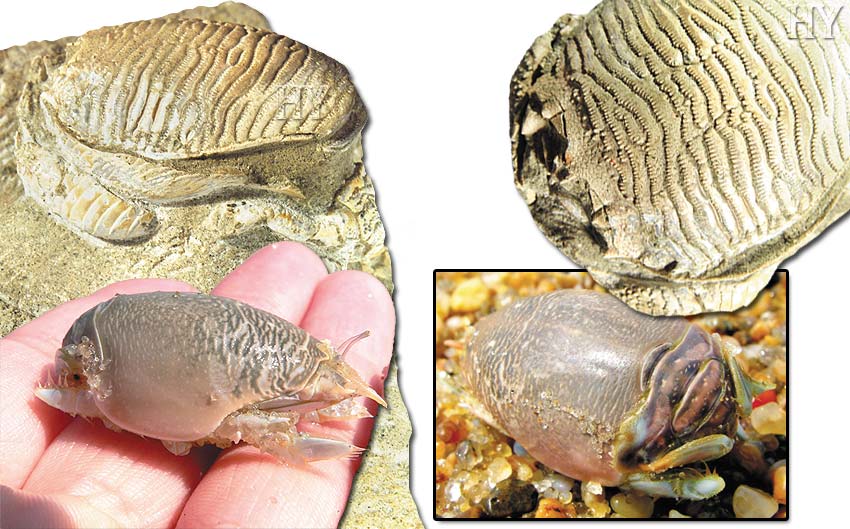
This species of crab, with a much smaller body than that of other crabs, has five pairs of legs but no claws. This typical characteristic was also present in Ranila crabs 50 million years ago.
What fossils show us is that life forms have never changed, in other words, that they never evolved.
Period: Eocene
Age: 50 million years
Region: Tuscany, Italy
Like all created life forms, the Ranila crab has not changed at all over millions of years. Allah has preserved them just as they always are. This is evidence that evolution never happened and that Almighty Allah creates all living things. The fact the Ranila crab has remained unchanged despite the intervening 50 million years invalidates evolutionists’ claims and proves to the entire scientific world that evolution never happened.
This life form has a much smaller body than that of other crabs and possesses five pairs of legs, with no claws. It constantly moves backward. They bury themselves in the sand when the tides are coming in and out for protection against predatory birds. Allah certainly bestowed all these characteristics on them. The fact that this life form has remained unchanged despite the passage of 50 million years show that evolutionists are not telling the truth and that theirs is a totally imaginary scenario.
Bowfin (Amia calva)
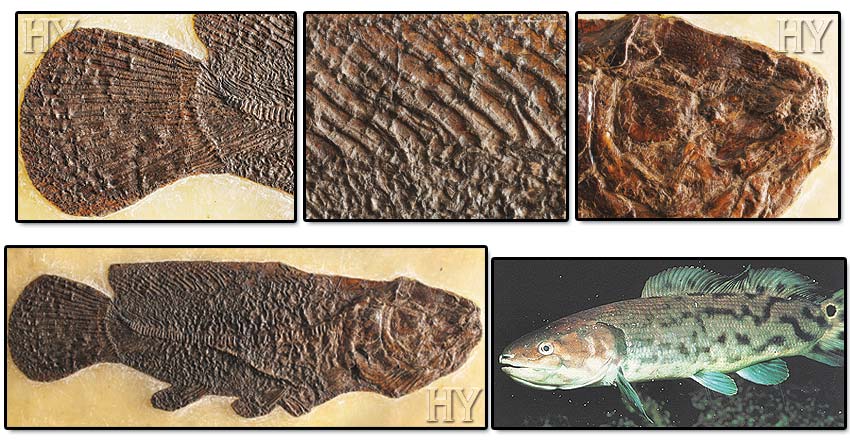
The sharp teeth, jaw structure, fins and detail in the tail have all been preserved in this bowfin fossil dating back 50 million years. This fossil shows that the fish has never changed and reveals the invalidity of the theory of evolution.
Period: Eocene
Age: 50 million years
Region: Messel Formation, Germany
Since the theory of evolution is not based on any scientific evidence and is kept propped up with fabricated scenarios and propaganda techniques, it is impossible to find any fossil to corroborate this fictitious theory. Darwinists have written a fictitious natural history and have sought to make fossils fit that theory; but the exact opposite has happened, and every new fossil discovery places the theory of evolution in an even more impossible position.
The bowfin fossil in the picture dates back 50 million years. The animal’s sharp teeth, jaw structure, the fins beneath its body, the large, long fins on top of the body and the oyster-like tail have all been perfectly preserved and it has been realized that there is no difference between this specimen’s skeletal system and that of present-day bowfins. The bowfin lives in the muddy, sandy or reedy bottoms of lakes and rivers in Central and Eastern Anatolia. It feeds on small animals, insects and larvae from the mud it sucks up on the bottom. It can withstand the high temperatures of shallow waters. A 50-million-year-old fossil specimen of this life form reveals the invalidity of the theory of evolution.
Capros Fish (Boar Fish)

The 37 to 23-million-year-old capros fish in the photograph is identical to the present-day specimen on the right and is one of the most important pieces of evidence that evolution is a deception.
Period: Oligocene
Age: 37 – 23 million years
Region: Poland
Paleontological research over the last 150 years or so has never unearthed a single fossil that might serve as evidence for the theory of evolution. All the fossils unearthed show that life forms never evolved.
A comparison of a living capros fish with a fossil form dating back 37 to 23 million years clearly shows that the fins emerging from the animal’s back, the structure of its skull and its tail have never changed. The fish is almost as wide as it is long. Six species of this fish live in the depths of the Atlantic, Pacific and Indian Oceans. Allah created this species of fish as He did all other living things, and the animal has come down to us completely unchanged to the present day.
Herring
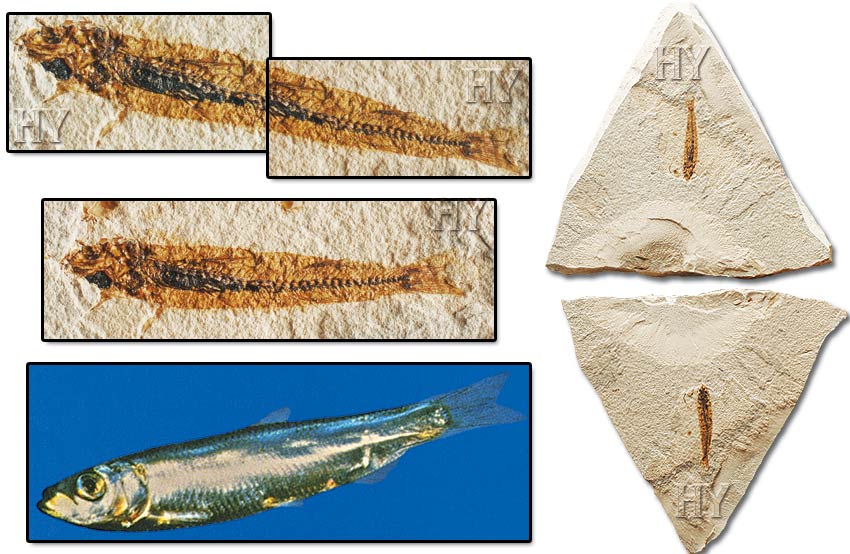
The fossil in the picture is a double aspect, negative-positive one.
Herring, which move in large schools and feed on plankton, travel very great distances. As can be seen in detail in this 50-million-year-old fossil herring, not the slightest alteration has taken place in its body.
Period: Eocene
Age: 50 million years
Region: Monte Bolca, Italy
Herrings are fish approximately 30 cm (12 inches) long that live in northern seas. Its body is flattened at the sides, its back is blue-green in color and its stomach silver. They travel in large schools and feed on plankton. The fish has a life span of approximately 18 years. There are two species of herring; one never leaves the sea, while the other comes to river mouths to breed.
Herring travel for long distances as plankton change location. At breeding time, they form schools consisting of millions of members. The eggs that attach to stones and seaweed form a layer 1 cm (0.39 inches) thick in some places. The baby herring that hatch from the eggs are hunted by other animals. Therefore, although few grow to full size they again form large schools. The fact that a herring fossil dating back 50 million years is identical to a herring living today proves to the scientific world that evolution never happened.
Shrimp
Period: Jurassic
Age: 150 million years
Region: Germany
The fact that a fossil of a living thing that existed 150 million years ago can be preserved so perfectly, and that as a result we have the possibility of observing every detail in its body, has dealt a severe blow to the theory of evolution. The anatomy of the shrimp in the picture, that lived 150 million years ago, the legs emerging from its body and the structure of its head, can all be seen quite clearly. Shrimps have survived completely unchanged for 150 million years and clearly show that Darwinists, who maintain that living things are in a constant state of change from the supposedly primitive to the more advanced, are not telling the truth.
The shrimp lives in European seas and the shores of North America, and belongs to the crustacean class. It has a cylindrical body and long antennae. It is covered in armor made of calcium carbonate. Its body is jointed. It swims backward by waving its fin-like tail. Its tail is pronounced and resembles a fan in appearance. Its two pairs of antennae are very long and forked. At least one of these forks curves backward, enabling the shrimp to edge backward into cracks and crevices and warning it of danger approaching from behind. The shrimp’s most distinctive action in the face of danger is to seek to protect itself by a sudden bending of the body. It can adapt its body color to blend in with its surroundings. Some species have large claws and feed on small fish, while others scavenge on food particles among the sand. Some of these species have brush-like hairs on their claws to help them gather up food particles.
Atlantic Cod
Period: Oligocene
Age: 37-23 million years
Region: Poland
Darwinists claim that all life forms change and evolve from one another; that is why fossil specimens that lived millions of years ago are so important. Life forms have remained unchanged despite the passage of millions of years. One single living fossil is by itself sufficient to prove this, though the Earth is full of countless living fossils.
One specimen that invalidates the theory of evolution is a 37 to 23-million-year-old Atlantic cod fossil. Examination of the animal’s skeletal structure, head, tail and fins shows that its anatomical features are identical to those of specimens living today. Cod are migratory fish that live in temperate and cool seas at depths of between 30 to 300 meters (100 to 1,000 feet). They have long, thin bodies and vary in size between 20 to 50 cm (eight to twenty inches), depending on the species. They may weigh up to one to two kg (two to five pounds). Cod travel in schools and feed on small fish and crustaceans. A female cod lays around 200,000 eggs. As with fossil remains of other species, this Atlantic cod fossil proves that evolution never happened.
Crayfish

The fossil in the picture is a double aspect, negative-positive one.
The large claws on the front of the 160-million-year-old crayfish fossil in the picture, the structure of its head and feet, and its slightly backward curving body are identical to those of present-day specimens and have never changed in any way.
Period: Jurassic
Age: 160 million years
Region: Yixian Formation, Liaoning, China
An average adult crayfish is 10 to 15 cm (four to six inches) long, two to three 2-3 cm (0.75 to one inch) wide and weighs 40 to 50 grams (1.4 to 1.7 ounces). They generally inhabit muddy and sandy areas. By day, they conceal themselves in holes they dig in these areas or under rocks among plants. At night, they come out to feed. They consume both animal and vegetable foodstuffs. Crayfish change their shells eight times during their youth and one to two times a year as adults.
Not one of the transitional forms evolutionists have been talking about for 150 years has ever been found in the fossil record. The 160-million-year-old crayfish in the photograph has never changed in any way. Different living species appear separately, in a single moment and with all their particular structures, with no so-called evolutionary “transitional forms” between them. This once again proves that Allah creates all living things.
Dentex
Period: Eocene
Age: 50 million years
Region: Monte Bolca, Italy
The head structure, the short fins on the body, the tail divided in two parts and the small fins beneath the body can all be clearly seen in this 50-million-year-old dentex fossil from the Eocene period.
With all their details, fossils preserved in stone totally discredit all evolutionary scenarios. Allah has preserved the fossil remains of things that lived millions of years ago in stone, literally like photographs. The scientific world has thus been able to observe that life forms have never changed in the slightest and that they never evolved. Darwin admitted in the chapter “Difficulties on Theory” in his book The Origin of Species that this represented a major dilemma for his theory:
“... Why, if species have descended from other species by insensibly fine gradations, do we not everywhere see innumerable transitional forms? Why is not all nature in confusion instead of the species being, as we see them, well defined?… But, as by this theory innumerable transitional forms must have existed, why do we not find them embedded in countless numbers in the crust of the earth?… Why then is not every geological formation and every stratum full of such intermediate links? Geology assuredly does not reveal any such finely graduated organic chain; and this, perhaps, is the most obvious and gravest objection which can be urged against my theory.” (Charles Darwin, The Origin of Species, pp. 172, 280)
Chimaera
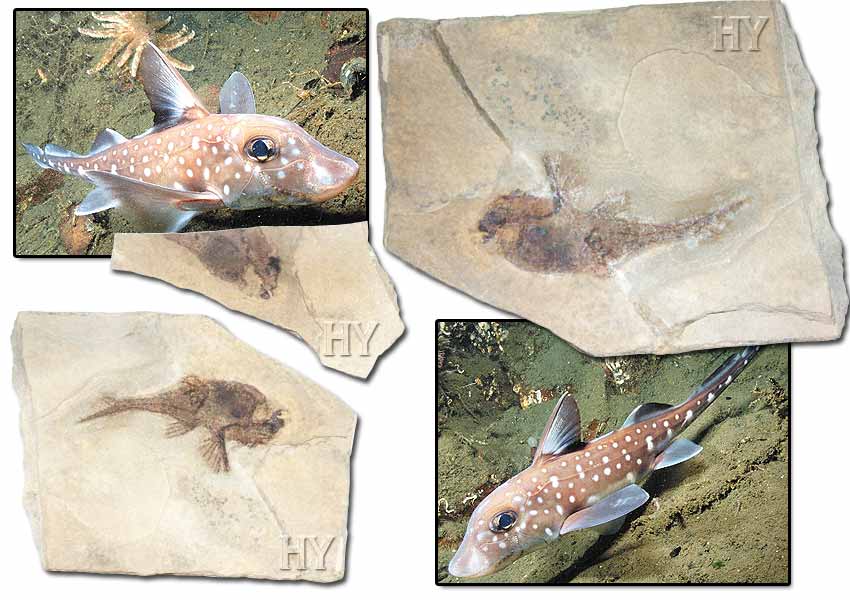
There is not one single piece of evidence that evolution ever happened. Millions of fossils from tens of thousands of species have been discovered to date. But all of these belong to complete, fully formed and complex life forms with a perfect appearance.
This chimaera with its unique appearance was swimming in the seas 320 million years ago and has come down to us unchanged to the present day.
Period: Carboniferous
Age: 320 million years
Region: Montana, USA
The picture shows a 320-million-year-old fossil chimaera, perfectly preserved with its fins, head and tail. These fish, with splendid teeth, fins on either side, eyes resembling those of human beings and a 30 cm (12 inch) long whip-like tail, have never changed over the course of 320 million years. The fossil shows all the animal’s details, as well as the fact that it has never changed. The invalidity of the theory of evolution is becoming clearer with every passing day due to the evidence provided by the fossil record. Allah creates all living things with His infinite knowledge and artistry.
Grinner Fish
Period: Cretaceous
Age: 95 million years
Region: Lebanon
Evolutionists cannot point to a single transitional form they could use as evidence against the fact of creation. Were the evolutionists’ claims true, then the fossil record should contain millions of transitional forms evolved from millions of species in the universe. But there exists not one transitional form in the fossil record, and all the fossils that have been discovered prove that life forms have never changed, that they never evolved. This 95-million-year-old grinner fish fossil from the Cretaceous period is one specimen showing that this life form has never changed despite the intervening millions of years. The evolutionist scientist Gordon Rattray Taylor admits to these dilemmas facing the theory of evolution as follows:
“It is a striking, but not much mentioned fact that, though geneticists have been breeding fruit-flies for sixty years or more in labs all around the world—flies which produce a new generation every eleven days—they have never yet seen the emergence of a new species or even a new enzyme.” (Gordon R. Taylor, The Great Evolution Mystery, New York: Harper & Row, 1983, p. 48.)
Sturgeon
Period: Jurassic
Age: 150 million years
Region: China
The sturgeon is a freshwater fish comprising the Acipenseridae family, up to eight meters (25 feet) long and weighing up to 1.6 tons. Their skeletons are only partly cartilaginous. They have five rows of large scales along their flanks. Their tails are asymmetrical, their mouths point downward and they can make their mouths protrude when necessary. They have four whiskers, which enable them to seek food on the bottom. Most species of sturgeon only come to fresh water to breed and generally live in salt water. The largest species of sturgeon, the beluga sturgeon, lives almost exclusively in salt water and comes from the sea to fresh water to lay its eggs. The 150-million-year-old sturgeon fossil in the picture completely refutes the evolutionist idea that life forms are descended from one another. The fossil proves that, as with specimens living today, the fish’s tail structure, the fins right to the side of the head and the other fins on its body have never changed. Like all other living things in the universe, the sturgeon was created by Allah with infinite wisdom.
Herring
Period: Cretaceous
Age: 144-65 million years
Region: Morocco
Robert Shapiro, a professor of chemistry and expert on DNA from the University of New York has calculated the probability of the 2,000 types of protein in just one simple bacterium emerging by chance. The figure he obtained was a probability of 1 in 10 plus 40,000 zeroes. Prof. Chandra Wickramasinghe comments:
“It [one to a number with 40,000 naughts after it] is big enough to bury Darwin and the whole theory of evolution. There was no primeval soup, neither on this planet nor on any other, and if the beginnings of life were not random, they must therefore have been the product of purposeful intelligence.” (Sir Fred Hoyle, Chandra Wickramasinghe, Evolution from Space, p. 148)
The 144 to 65-million-year-old herring fossil in the photograph clearly proves that fish are created to always be fish, and that they never evolved into any other life form. The millions of fossils extracted from the Earth’s rock strata have dealt a severe blow to the theory of evolution and expose its invalidity.
John Dory
Period: Oligocene
Age: 37 - 23 million years
Region: Carpathian Basin, Poland
The fossil record shows that all fish species exist with their own unique characteristics, that they have no evolutionary relationships with other species and that the idea of a “common ancestor of fish” is a completely imaginary one. The Turkish evolutionist Ali Demirsoy admits that the claims regarding different species of fish turning into one another are “based on hypothesis:”
"There are merely assumptions regarding the division of boned fish from the earliest known Paleozoic jawed fish." (Ali Demirsoy, The Basic Laws of Life, Vol. III, Part I, p. 248)
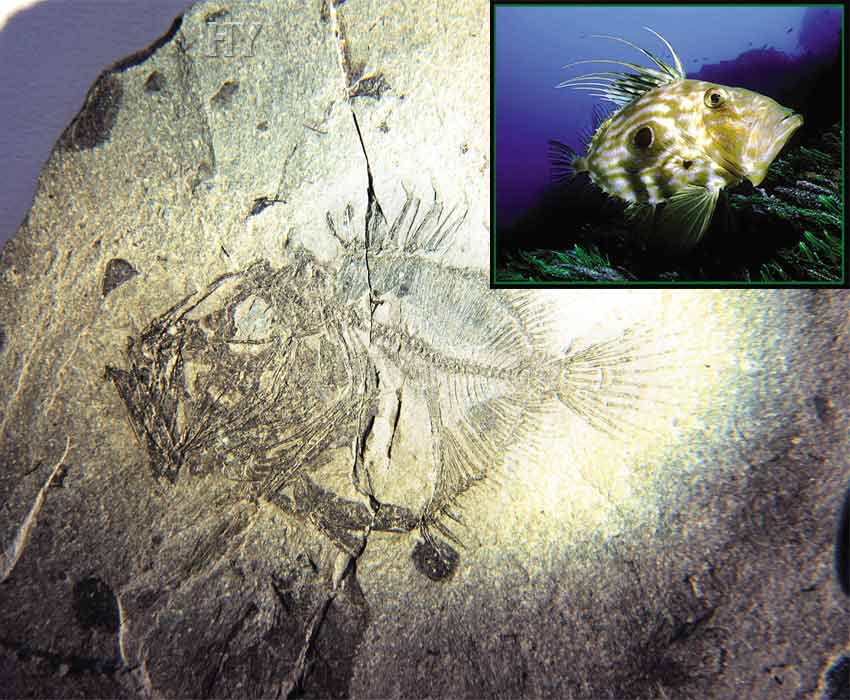
John Dory has a high, flat body and a wide mouth, and is covered in small scales.
The fact that this fish which lives close to the bottom, has not changed for 37 to 23 million years invalidates all evolutionary claims about the origin of life and shows that Allah creates fish and all other living things.
Just like its counterparts living today, the spiny fins protruding from the upper and lower body of John Dory in the picture and its tail structure are very clear. This fossil also proves that all the Darwinists’ claims are untrue. All living things in the universe are the work of our Lord Allah and they are all created with an unequaled artistry.
Minnow
Period: Miocene
Age: 23 – 5 million years
Region: Shang Dong Region, China
Minnows are freshwater fish belonging to the family Leuciscinae. This is a large family consisting of 48 species. Minnows are very small and live for only three to four years. Larger species live for between seven and ten years.
A 23 to 5-million-year-old fossil minnow clearly demonstrates that the fossil record refutes the theory of evolution. There is not the slightest difference between this 23 to 5-million-year minnow fossil and minnows living today. Fossil findings give the lie to the theory of evolution and prove the fact of creation.
Sand Lances (Ammodytes)
Period: Oligocene
Age: 37 - 23 million years
Region: Poland
Sand lances belong to the family Ammodytes and have a long, needle-like body and a small, forked tail. These fish are around 15 cm (6 inches) long. They bury their long, thin bodies in the sand to hide from predators. Thousands of these fish swim along together, looking for food. According to the theory of evolution, species supposedly evolved from one another gradually, in stages, by undergoing minute changes. But the long thin body, the head and tail of the living fossil in the picture have never changed at all. Evolutionists have been deceiving people with imaginary scenarios for many years. But, just like other species, the sand lance was created as a fish by Allah and has survived down to the present day as exactly the same fish.
Sawfish
The fossil in the picture is a double aspect, negative-positive one.
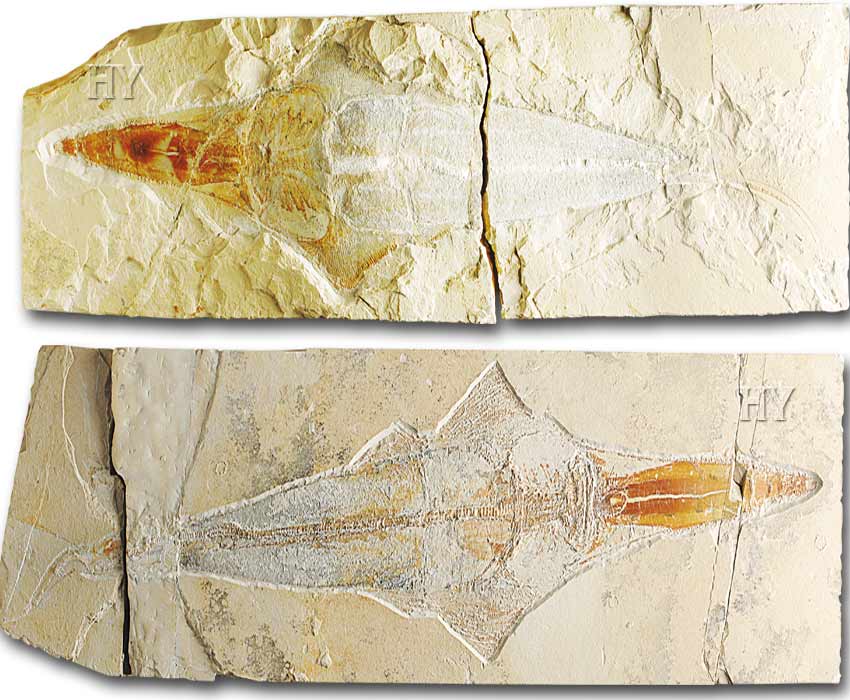
Period: Cretaceous
Age: 95 million years
Region: Lebanon
Sawfish belong to the family Pristidae. Their nose resembles a long saw, and they have two dorsal fins. They live in the Atlantic Ocean, the Mediterranean, the Pacific and northern Australia. These fish reach a maximum of 7.5 meters (25 feet) in length and generally live for up to 30 years. Examination of sawfish living today shows that they have the same characteristic saw-like nose and fins on the edges of their bodies as in this 95-million-year-old fossil.
Life forms living today also appearing in the fossil record deals a heavy blow to the theory of evolution because this 95-million-year-old fossil is identical to members of the species living today. The sawfish once again proves that living species have preserved their features up to the present day.
The sawfish, which can be seen in detail as it appeared 95 million years ago, has survived just as it was then, despite the intervening millions of years. Its two dorsal fins and all other details show us that these living things have remained unchanged for millions of years. Furthermore, the stasis in life forms, the way they remain unchanged, shows that Allah, the Almighty and Merciful, creates all life forms in a single moment.
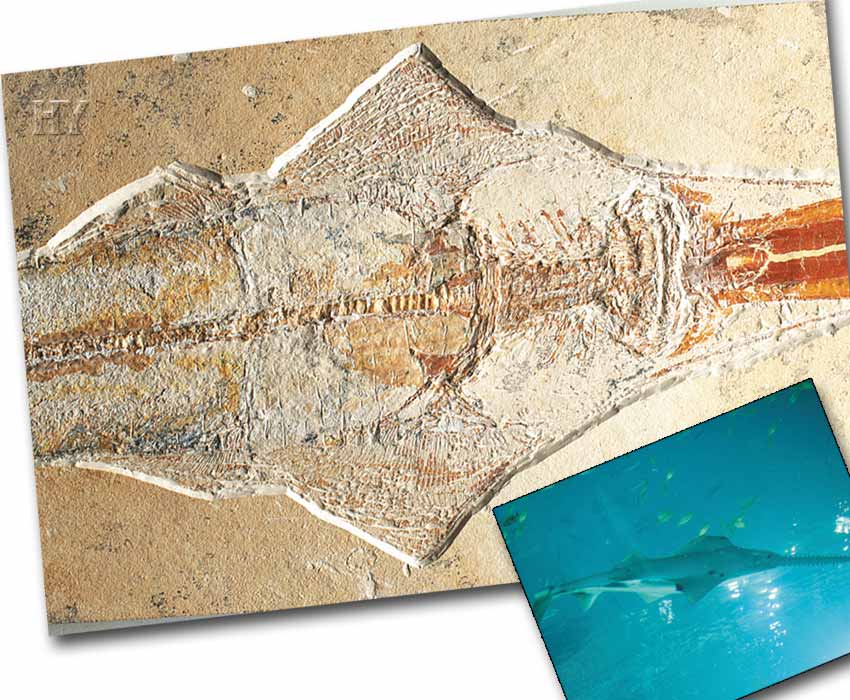
Catshark
Period: Cretaceous
Age: 95 million years
Region: Lebanon
The catshark is a member of the shark family. These fish live in warm seas at depths from 3 to 1,000 meters (appr. 10 to 10,000 feet) and do not make long migrations. They feed on crustaceans, invertebrates and small fish. Their length ranges from 50 to 150 cm (20 to 60 inches). This species lays its eggs in the fall in a sac it deposits among the rocks and can lay eggs several times a year.
The head of the catshark, resembling that of a small shark, and its small fins can clearly be seen in this 95-million-year-old fossil. The fossil shows that, despite the passage of millions of years, catsharks have remained the same since the day they were first created. Allah has created millions of species living beneath the sea, and they are all the work of His sublime artistry.
Stingray
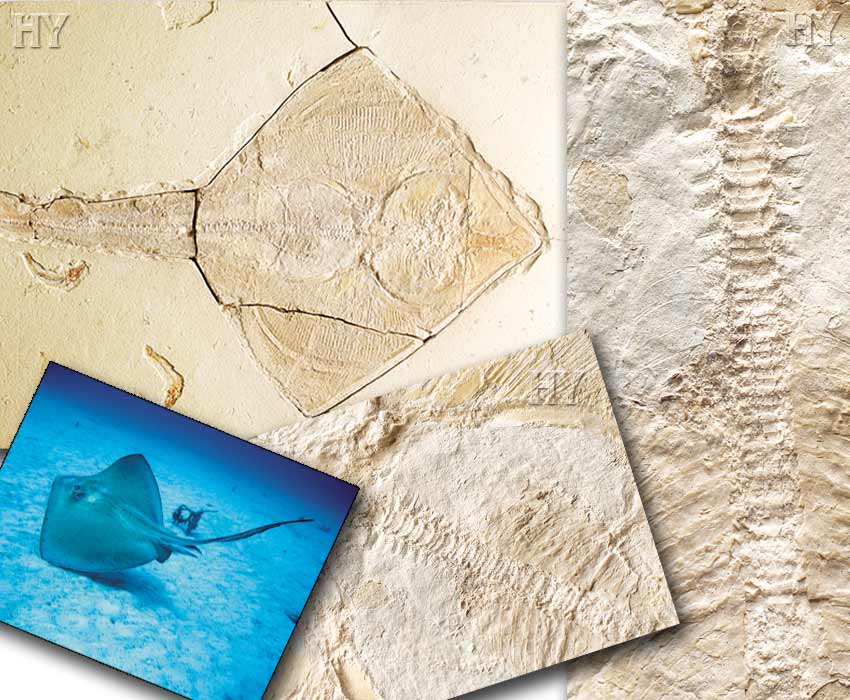
The most distinguishing feature of the 180 species of ray is their long tail.
Stingrays use their electricity generating tails solely for defensive purposes. All the details in the body of this 95-million-year-old stingray fossil are clear and show that this life form has remained the same for millions of years.
Period: Cretaceous
Age: 95 million years
Region: Lebanon
Stingrays, with their flat bodies, belong to the order Rajiformes. They are particularly common in the shallow seas of Europe and bury themselves in the sand. The male is approximately 70 cm (27 inches) long, and the female 125 cm (50 inches). There are as many as 180 individual species. The skin is thin and slippery. Their backs are brown and their stomachs silvery. They have large chest fins attached to both sides of the body. The electric organs in their tails are used solely for defensive purposes. These fish hunt at night and feed on small fish, crustacean and plankton.
The 95-million-year-old fossil stingray in the picture proves that this life form has never changed, that it never evolved.
Lanternfish
Period: Miocene
Age: 8 million years
Region: Italy
Lanternfish live in deep waters in various oceans. These small fish have light-emitting organs in their bodies. These light emitting organs are generally in their abdominal regions. Since they inhabit deep, dark waters they use their light both to illuminate their surroundings and also to warn off predators. Evolutionists have no explanation whatsoever for how these fish came to possess a highly complex system capable of emitting light from their bodies many millions of years ago because evolutionists claim that living things evolve from the primitive to the more advanced.
Allah created the eight-million-year-old fossil lanternfish in the picture together with all its complex systems.
Pipefish
Period: Pliocene
Age: 4 million years
Region: Italy
When he proposed his theory of evolution, Darwin never imagined that fossils dating back millions of years would be preserved, and that these formerly living things would literally survive down to the present day as if they have been photographed. However, the millions of fossils that have been unearthed show that life forms have never changed and that they are the same today as the day they were first created.
The four-million-year-old fossil pipefish in the picture shows that this life form has never altered in the slightest. The fossil record reveals that living things never evolved and that Almighty Allah created them all.
Bivalve
Period: Jurassic
Age: 206-144 million years
Region: Majunga Basin, Madagascar
These organisms feed by filtering food particles from water. Their bodies consist of two symmetrical shells joined by a hinge. They live in fresh water. Sand mussels and oysters are also members of this class.
The fossil shows that not the slightest change has taken place in this life form despite the passage of between 206 to 144 million years. If, like other life forms, this one has not undergone the slightest alteration over 206 million years, then it is impossible to speak of an evolutionary process. Bivalves were created with all the features they possess today.
Moon Coral
Period: Devonian
Age: 350 million years
Region: Atlas Mountains, Morocco
Moon corals inhabit the Caribbean and Red Seas and the Pacific and Indian oceans. They feed on phytoplankton, sediment and wastes. Although moon corals are invertebrates, their fossils have nonetheless been very well preserved. A 350-million-year fossil shows that this life form has come down to the present day with all its characteristics and that it has never changed. Despite the passage of 350 million years, this coral never turned into an amphibian, and then a reptile, and then into a bird or a mammal. It has come down to the present day exactly as it was created so many millions of years ago.
Prof. Chandra Wickramasinghe admits the following facts regarding the theory of evolution:
“From my earliest training as a scientist, I was very strongly brainwashed to believe that science cannot be consistent with any kind of deliberate creation. That notion has had to be painfully shed. At the moment, I can't find any rational argument to knock down the view which argues for conversion to God. We used to have an open mind; now we realize that the only logical answer to life is creation—and not accidental random shuffling.” (Chandra Wickramasinghe, Interview in London’s The Daily Express, August 14, 1981)
|
